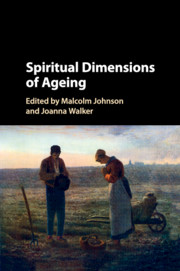Book contents
- Frontmatter
- Contents
- List of Contributors
- Preface
- Acknowledgements
- 1 Spirited Ageing
- Part I The Spiritual Journey of Ageing
- Part II Cultures of the Spirit in Modernity
- Part III Searching for Meaning in Later Life
- 10 Religion, Faith, Belief and Disbelief in Old Age: “A full-hearted evensong”
- 11 Finding Meaning and Sustaining Purpose in Later Life
- 12 Spirituality, Biographical Review and Biographical Pain at the End of Life in Old Age
- 13 Embracing Contraries: The Spiritual Quest as a Lifelong Process
- Part IV Meeting Spiritual Needs in Older Age
- Index
- References
10 - Religion, Faith, Belief and Disbelief in Old Age: “A full-hearted evensong”
from Part III - Searching for Meaning in Later Life
Published online by Cambridge University Press: 22 December 2016
- Frontmatter
- Contents
- List of Contributors
- Preface
- Acknowledgements
- 1 Spirited Ageing
- Part I The Spiritual Journey of Ageing
- Part II Cultures of the Spirit in Modernity
- Part III Searching for Meaning in Later Life
- 10 Religion, Faith, Belief and Disbelief in Old Age: “A full-hearted evensong”
- 11 Finding Meaning and Sustaining Purpose in Later Life
- 12 Spirituality, Biographical Review and Biographical Pain at the End of Life in Old Age
- 13 Embracing Contraries: The Spiritual Quest as a Lifelong Process
- Part IV Meeting Spiritual Needs in Older Age
- Index
- References
Summary
Introduction
In the process of socialization, individuals are introduced to manifold ideas and beliefs about the purpose of life and the ways in which group members are expected to act as they move through life. Our lives are simultaneously personal and social; that is to say our identity is intertwined within these strands though how tightly or loosely varies. Religion is a system of beliefs and behaviors connected to the sacred (Durkheim, 1965) howsoever the sacred is defined within a society or culture. Indeed, there are likely to be several religious social worlds in any society with differing perspectives on the sacred and unique emphases on the divine with attendant observance or practice differing.
Some religions have complex beliefs and social roles, others offer a blend of ideas and behavioral desiderata consonant with meanings and understandings that are clearly and simply arrayed. Communal gathering to act on religious beliefs similarly exhibits a range from solitary worship and communal meeting for social purposes to communal practice with little emphasis on personal or private practice outside of communal worship. Sociologically speaking, religions are the same and yet different from other social institutions or social worlds that orient group members to a larger social reality or culture. In other words, religions shape social identity in linking individuals to others. The focus of religious beliefs and behaviors is unique with regard to transcendence and is responsive to human needs. Other social institutions meet different human needs and they too shape identity. A single way of connecting to others vitiates the tie between person and group and redounds unfavorably for each. Likewise the content and focus of beliefs and behaviors coalesces around some shared ideas and behaviors in order to foster a commonality or social solidarity that unifies members apart from their membership in unique social worlds. Analytically, some social worlds articulate ways of moving through time and place in order to reproduce themselves and to move their members into another “better” or other-worldly direction.
For more than ninety years, beginning in 1922 for American social gerontologists with publication of Senescence by G. Stanley Hall, the aging experience has been tethered to historical, generational, and social contexts as much as it is understood to be a personal or individual experience. Life course is built by the individual and surrounding social structure.
- Type
- Chapter
- Information
- Spiritual Dimensions of Ageing , pp. 157 - 178Publisher: Cambridge University PressPrint publication year: 2016
References
- 1
- Cited by

